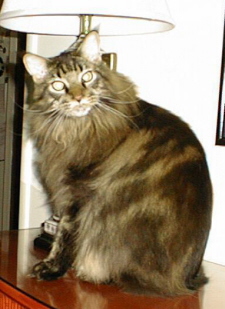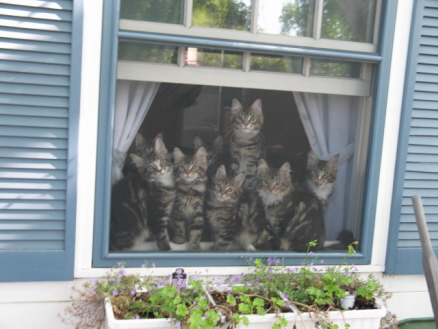
Windwalker Maine Coon Cats
Why we love Maine Coons
| Home | Boys | Girls | Kittens | Care & Feeding | Why we love Maine Coons | Links | Hasta Luego | Email us |
|
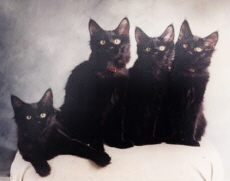 |
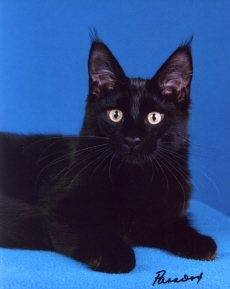 |
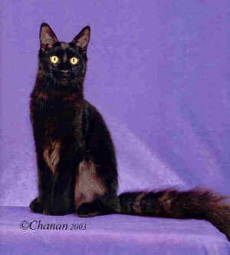 |
| ^ Windwalker Batman, six months old |
Maine Coon Cats have added an incredible dimension of beauty and calm to our home. We've always loved cats, but Maine Coons are really special. Very people-oriented, they like to be with you but they're so calm that, in spite of their size, they don't dominate the room. Sometimes we're amazed when we realize how many big cats are in the room with us, each sleeping or watching us calmly from their current favorite place. Our love for black Maine Coons began with the Lone Ranger. Then we got a brown tabby, Kemosabe, and after a couple of years we decided to get a female for breeding so we could share with others the joy of having these wonderful cats. |
| Description of the Breed |
|
Strong, tranquil and intelligent, the Maine Coon Cat is a wonderful companion and has become a very popular breed. One of the oldest natural breeds in North America, the Maine Coon is America's native longhair cat. Maine Coon Cats evolved in the state of Maine. In fact, the Maine Coon is the official Maine State Cat. Most breeders today believe that the breed evolved naturally from short-haired and long-haired cats that jumped ship at ports in Maine or came with settlers to Maine in the early 1600's and 1700s. These cats developed distinctive characteristics that helped it survive the cold, harsh New England winters and in the isolated area of Maine, these characteristics became recognizable and known as the Maine Coon cat. Everything about the Maine Coon indicates its adaptation to a harsh climate. The glossy coat is heavy and water-resistant, longer on the ruff, stomach, and britches to protect against wet and snow, shorter on the back and neck to guard against tangling in underbrush. The coat falls smoothly and only needs to be combed once a week to keep it looking nice. The Maine Coon can wrap its long, bushy tail around its body to protect itself from cold winters. The big, round, tufted feet help the cat negotiate uneven terrain and walk in the snow. The large ears and eyes are survival traits, to increase sight and hearing. The ears are heavily furred (both inside and on the tips), for protection from the cold, and have a large range of movement so the cats can hear well in the barns and woods. The long, square muzzle helps a Maine Coon Cat grasp prey and drink water from streams or puddles. In the United States, where many domestic long-haired cats have developed in cold climates, lots of cats have some of the characteristics of a Maine Coon cat, but the only way to know for sure a cat is a Maine Coon is to have its pedigree and registration forms. |
Now that we have lived with our Maine Coons, and watched how carefully the judges at cat shows evaluate them to see how they meet the standards, we realize that all the things we love about Maine Coons are actually all the characteristics of the standard: gentle, friendly personality, big, sturdy body, shaggy coat, bushy tail, elegant head, strong chin, boxy muzzle, big eyes, big ears with lynx tips and big paws with foot furnishings. Maine Coon Cats are tall, muscular, and big-boned, one of the largest domestic breeds. Males can weigh 13 to 21 pounds, and females normally weigh about 9 to 12 pounds. Maine Coons don't reach their full size until they are three or four years old and their dispositions remain kittenish throughout their lives. They are called the gentle giants, or the Golden Retrievers of the cat world, and Maine Coon breeders ensure that disposition by only breeding big, gentle, good-natured cats. Even their voice, a distinctive, chirping trill, is different than other cats. They rarely meow, and when they do, their soft, high-pitched mew doesn't fit their size! The important features of the Maine Coon are the head and body shape, and the texture and "shag" of the coat. The head is slightly longer than it is wide, presenting a gently concave profile with high cheekbones and large, wide at the base, moderately pointed, and well tufted ears. Ears are set well up on the head, approximately an ear's width apart. Lynx-like tufting on the top of the ears is desirable. The neck should be medium-long, the torso long, and the chest broad. The tail should be at least as long as the torso. One of their most distinctive features of a Maine Coon Cat is its eyes, which are large, round, expressive, and set at a slightly oblique angle. Overall, the Maine Coon should present the appearance of a well-balanced, strongly-built, rectangular cat. Because Maine Coon breeders strive to maintain the wonderful characteristics that make the breed so popular, it has not been bred to extreme variations. Our favorite description of the breed is that it looks like the cat you had when you were a kid. For more background, and a description of the standards, check out the Maine Coon sites we have linked to on the internet from our Links page. |
A number of legends surround the origin of the Maine Coon cat. Although the name "Coon Cat" which eventually was changed to "Maine Coon Cat," comes from the bushy tail and the most common coloring (a raccoon-like brown tabby), it is biologically impossible for the breed to have originated from matings between semi-wild, domestic cats and raccoons. Our favorite theory on the origin of the Maine Coon is that it sprang from the six pet cats which Marie Antoinette is said to have sent to Wiscasset, Maine when she was planning to escape France with the help of New England seaman Captain Clough. The house that Captain Clough supposedly built for her still stands across the Sheepscott river from Wiscassett in Edgecomb, Maine. The first recorded mention of the Maine Coon Cat in literature is a black and white cat named "Captain Jinks of the Horse Marines" in 1861. Maine Coons were popular competitors at county fairs and early cat shows in Boston and New York. In 1895, a brown tabby female named "Cosie" won Best Cat at the Madison Square Garden Show. Unfortunately, the popularity of the Maine Coon cat declined with the arrival in the early 1900s of the more exotic long-haired cats known as Angoras or Persians. Although the Maine Coon remained a favorite cat in New England, the breed did not begin to regain its former widespread popularity until the 1950's when cat fanciers began to record their pedigrees. By 1980, all the cat registries had recognized the Maine Coon, and it was on its way back to its former glory. Throughout their history there has been no restriction on acceptable patterns and colors, with the exception of the pointed (Siamese) pattern. As a result, Maine Coons cats come in a wide range of colors and patterns. Eye colors for all coat colors range through green, gold, and hazel (green-gold). Blue eyes and odd eyes (one blue eye and one gold, green, or hazel eye) are also permissible in white cats. There is no requirement for particular combinations of coat color and eye color. Many people consider Maine Coons the perfect domestic pets, with their clown-like personalities, affectionate natures, amusing habits and tricks, willingness to "help" with any activity, and easily-groomed coats. They make excellent companions and have a strong, healthy constitution. When you welcome a Maine Coon Cat into your home, you will join thousands of people that love this handsome and personable cat! |
Copyright © 2023 Windwalker Maine Coons - All rights reserved. | Updated 06/06/2020 | Contact Us

This work is licensed under a Creative Commons Attribution-NonCommercial-NoDerivs 3.0 Unported License.
